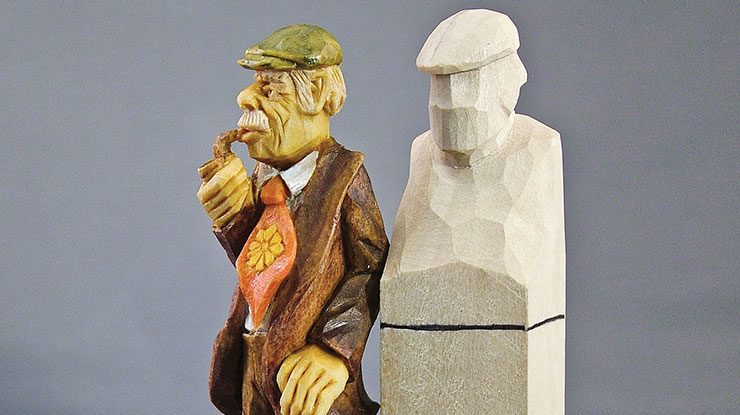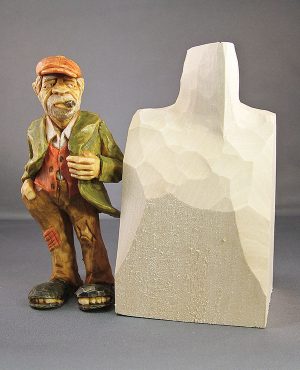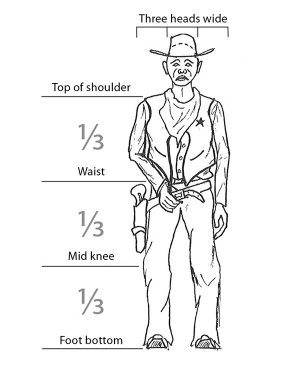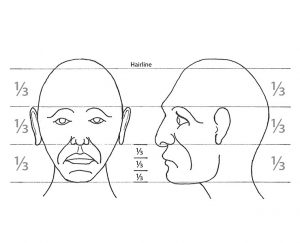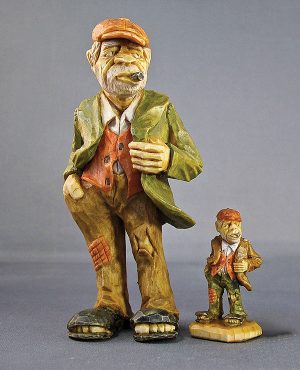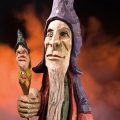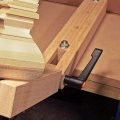Create accurate proportions in your figure carvings
By Donald K. Mertz
The rule of three is an easy way to envision a human figure in a block of wood before and during the carving process. All human figures have the same basic elements. These elements need to be in proportion to avoid creating a carving that looks distorted. The rule of three is a simple guideline to keep human figure carving in proper perspective and proportion. After learning about the rule of three, try the technique out on the hobo caricature below or a magical wizard from issue #64.
I carve my figures out of a block of wood with square corners. This raw carving medium gives me more freedom and allows me to be creative, rather than being limited by a predetermined pattern or outline of the sawn-out blank or rough out. This freedom allows me to come up with a unique design. Carving from a patterned sawn-out blank or a rough out limits creativity. While exercising your creative freedom, it’s important to maintain proper proportions in your figure. While you are engaged in cutting down the block of wood to the basic shape and form of the subject, it is helpful to have guidelines for the basic proportions. Proportional guidelines, such as the rule of three, will help you create a well-balanced and proportioned figure carving.
Applying the Rule of Three to a Carved FigureThe rule of three works for carvings of all sizes, from miniatures to life-size figures. It is easier to remember and apply the rule of three than the traditional guideline of a figure being eight head-lengths tall. By keeping the rule of three in mind, you can design any human figure and adapt it according to the clothing, age, race, and occupation of the figure. The rule of three works for any figure, from clowns and hobos, to Indians, pirates, and Santas. |
|
Body Proportions• Divide the body, below the head, into three equal sections: the shoulders to the waist, the waist to mid-knee, and mid-knee to the bottom of the feet. • Use the width of the head to determine the correct width of the body. At the shoulders, the body is three heads wide. |
|
Head Proportions• Divide the head into three equal sections: the hairline to the eyebrows, the eyebrows to the bottom of the nose, and the bottom of the nose to the bottom of the chin. • Position the ears in the center section. The ears sit on the back half of head and are the same length as the center section—from the eyebrows to the bottom of the nose. • The bottom section, between the nose and the chin is further divided into three equal sections: the nose to the upper lip, the upper lip to the indention between the bottom lip and the chin, and the indention to the bottom of the chin. |
|
|
Use the rule of three to block out the elements on the figure’s head. Note the head fits up into the cap; the cap does not sit on top of the head. Envision the top of the head inside the cap to produce the proper proportions.
Add details to the carving only after you have blocked out all of the elements. Continue using the rule of three to ensure the figure maintains good proportions. |
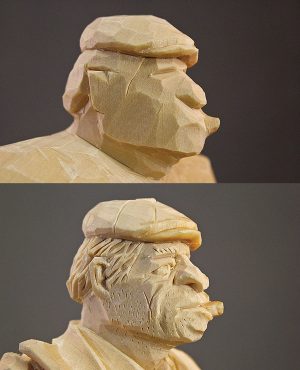 |
Carving Tips from the Wood Bee CarverDon Mertz, better known as the Wood Bee Carver, suggests would-be carvers would be carvers if they would carve wood. In addition to his rule of three for figure proportions, Don shares the following tips with would-be carvers. • While designing your carving and carving your design, think of the number 3 like the letter S, with curving lines that add flow and movement to the carving. Design and carve curving lines rather than straight lines. • Even though the blade is much longer, detail carving uses less than 1/4″ of the tip of any blade. • Hard lines carved into small carvings create light and shadows, making the carving appear to have sharp and precise details. Hard lines are created with angled under cutting along a stop cut. • Slice with the cutting edge of the tool as often as possible. A slicing cut separates the wood fibers and burnishes as it passes through the wood. A wedge cut, forced into the wood, breaks fibers ahead of the cutting action and creates fuzzies and ragged edges. Slice and do not pry. • Shape your knife to produce the results you desire. On my knives, the cutting edge curves up to meet the back edge of the knife blade. This allows me to make clean slicing cuts. |
|
• Sharp can be sharper. Make sure your tools are sharpened as much a possible and strop often. A sharp tool using a slicing cut creates a slick surface that makes the carving dance and the paint or finish sparkle. • Soak thin cross-grained areas with cyanoacrylate (CA) glue, such as Super Glue, to strengthen these areas, which are prone to breakage. • While a good carving relies on correct proportions, it’s important to add the details that transform a good carving to a great carving. Details such as seams, tears, patches, and worn out shoes help your carving tell a story. • Woodcarving is the journey more than the destination. There are no mistakes, only learning experiences. Relax and enjoy the journey. |
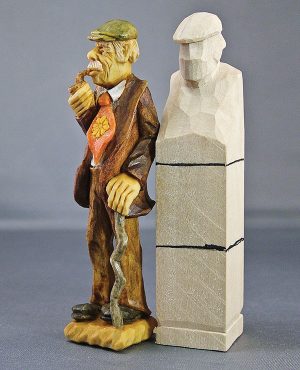 |
Paint Notes
|
|
| Materials
• Basswood, 2 1/2″ (6.4cm) square: 5″ (12.7cm) long (adjust pattern for blank) • Artist oil paints mixed with boiled linseed oil to a stain consistency: black, burnt sienna, burnt umber, cadmium red, raw sienna, sap green, white • Finish, such as Deft® brush-on lacquer |
Tools
• Carving knife or tools of choice
|
| About the Author |
|
Donald K. Mertz, a.k.a The Wood Bee Carver, has been carving seriously since the early 1970s. Don has written articles for Chip Chats, and taught at War Eagle Seminars and in Southwest Ohio for local clubs and Woodcraft stores. Don was elected into the Caricature Carvers of America in 2009 and shares his unique style of carving using only a knife through his educational web blog at woodbeecarver.com. Don is a retired Disciples of Christ pastor living in Wilmington, Ohio, with his wife, Frances. |
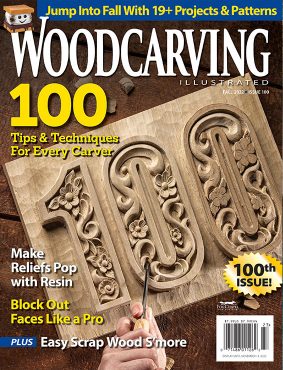 |
Get the Fall 2022 Issue Purchase the IssueFor more articles like this, subscribe to Woodcarving Illustrated magazine. Magazine SubscriptionPlus! Get digital mini magazines in your e-mail between printed issues.
|


